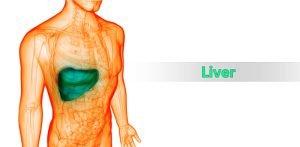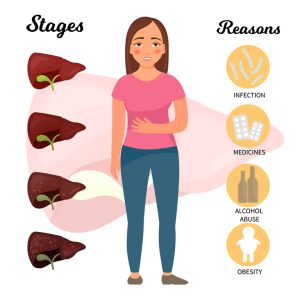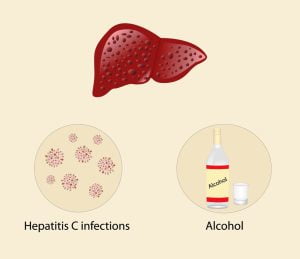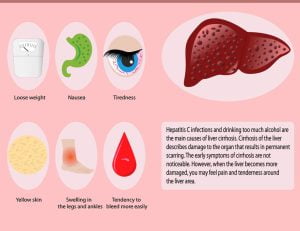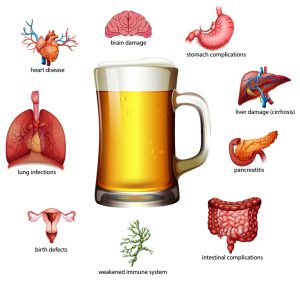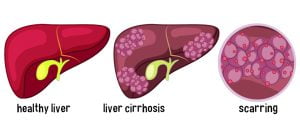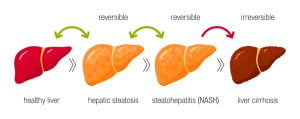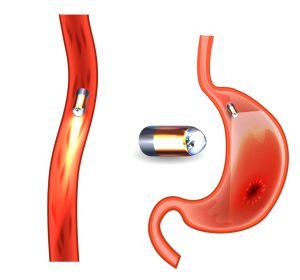Browsing: Liver Cirrhosis Graphics
Comprehensive Information, Resources, and Support on Liver Cirrhosis
Liver is a cone shaped, dark reddish-brown organ located in the upper right-hand portion of the abdominal cavity, beneath the diaphragm, and on top of the stomach, right kidney, and intestines. Its function is to detoxify chemicals, metabolize drugs, filter blood, produce certain proteins for blood plasma, etc. There are several diseases associated with dys-functionality of liver such as hepatitis, liver cancer, cirrhosis, liver failure, etc. Liver cirrhosis leads to long-term and extensive damage to the liver. It involves loss of liver cells and irreversible scarring of the liver. Cirrhosis occurs due to alcoholism, viral hepatits or non-alcoholic fatty liver.
Main causes of cirrhosis are chronic alcohol abuse, chronic viral infection such as (hepatitis B and C) and fat accumulation in the liver (nonalcoholic fatty liver disease). Other associated causes of cirrhosis are hemochromatosis, cystic fibrosis, genetic digestive disorder (Alagille syndrome), infection, such as schistosomiasis or syphilis, over-use of medications such as methotrexate, etc. The first stage of liver cirrhosis is inflammation of the liver which upgrades to fibrosis or scarring. Cirrhosis is the last stage of liver damage which ultimately leads to liver failure.
Cirrhosis is a complication of liver disease which involves loss of liver cells and scarring of the liver that is not reversible. Alcohol and viral hepatitis B and C are the two main causes of cirrhosis, although there are many other causes.
Cirrhosis is the severe scarring of the liver and poor liver function at the terminal stages of chronic liver disease. The scarring is generally caused by long-term exposure to alcohol or viral infections. Symptoms of cirrhosis may include such as decreased appetite, nose bleeds, jaundice (yellow discoloration), small spider-shaped arteries underneath the skin, weight loss, anorexia, itchy skin, and weakness. Severe damage can lead to liver failure and possibly death.
Use of herbal medicines for the treatment of liver diseases is famous from a long time. There is no known treatment to cure liver cirrhosis but herbal medicines help to reduce the symptoms and keep it under control. Papaya seeds, cumin powder, turmeric, grapefruit, avocado, gooseberry, oats, etc should be added to the diet as they help to improve liver function. Commonly used herbal preparations such as katuki, phyllanthus, silybum marianum (milk thistle), glycyrrhizin (licorice root extract), Liv-52 (mixture of herbs), etc are used to improve the function of liver.
Alcohol affects the body in multiple ways as it is rapidly absorbed in the body tissues. Alcohol stays in the blood until the liver breaks it down. The liver breaks down the alcohol into the blood and the kidneys filter it. Only 1/10 of the alcohol is washed out in this process. Effects of alcohol can be drastic on the central nervous system in the long-term. Excess consumption of alcohol also causes heart problems such as heartbeat irregularity, increased blood pressure, stroke, stretching of the heart muscle, etc. Other effects of alcohol on the body are birth defects, intestinal complications, lung infections, liver damage, obesity, etc.
Liver filters the blood coming from the digestive tract and then passes it to the rest of the body. Scarring of the liver or cirrhosis is a chronic liver disease. Scarring of liver occurs due to long-term exposure to toxins such as alcohol or viral infections (such as hepatitis). Another term for liver scarring is fibrosis. Symptoms are not visible until cirrhosis reaches a later stage (permanent scarring). Late stage symptoms are fluid accumulation in abdomen (ascites), jaundice, testicular atrophy in men, etc.
Liver is one of the most important organs of the body and any disease related to it cannot be easily treated. One of the reasons for this is that the symptoms of liver diseases are rarely visible during early stages. In an initial stage, inflammation of the liver or bile duct is the first sign but it leads to abdominal pain. Inflammation occurs due to excessive accumulation of fat inside the liver cells and is called hepatitis steatosis. In stage 2, scarring of liver begins and results in steatohepatitis. This is also due to abnormal buildup of fat in the liver and fibrosis. In final stage, severe scarring blocks blood flow. This leads to problems such as cirrhosis, liver failure, or liver cancer, etc.
Capsule endoscopy is a procedure that uses a tiny wireless camera to take pictures of your digestive tract. This helps in the diagnosis of GI problems such as esophageal cancer and liver cirrhosis. Capsule endoscopy (CE) has recently developed as an important procedure in the investigation pathway of patients with suspected liver cirrhosis. In a capsule endoscopy, the patient swallows a capsule which contains a camera which views the digestive tract for signs of cirrhosis.
ADVERTISEMENT




